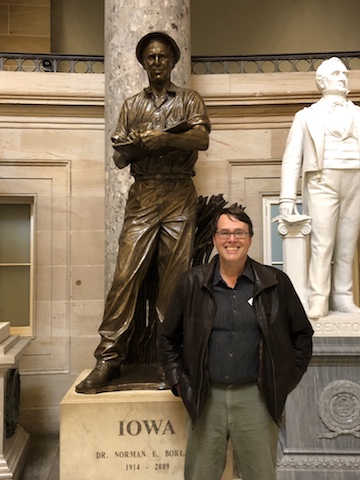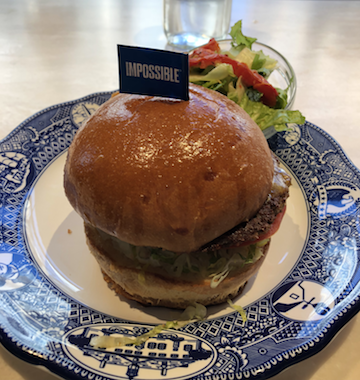 If you are planning a huge, calorie-dense feast for dinner later this week, you might want to take a moment to thank a man you’ve likely never heard of—a man whose scientific breakthroughs in agriculture made food cheaper and more plentiful around the world. Norman Borlaug may have saved up to a billion lives by breeding up new short, high-yielding varieties of wheat, often running field trials personally, plowing, planting, and harvesting by hand. Combined with irrigation and synthetic fertilizer, Borlaug’s plants ushered in the “green revolution,” in which crop yields skyrocketed from India to Iowa, his home state. In the biography written to introduce him as the winner of the 1970 Peace Prize, he was described as both “an eclectic, pragmatic, goal-oriented scientist,” and “a vigorous man who can perform prodigies of manual labor in the fields.” The Nobel prize committee often calls at five in the morning to make sure they find their winners at home. When they called for Borlaug, his wife told them that he had been already out in the field, working, for a solid hour.
If you are planning a huge, calorie-dense feast for dinner later this week, you might want to take a moment to thank a man you’ve likely never heard of—a man whose scientific breakthroughs in agriculture made food cheaper and more plentiful around the world. Norman Borlaug may have saved up to a billion lives by breeding up new short, high-yielding varieties of wheat, often running field trials personally, plowing, planting, and harvesting by hand. Combined with irrigation and synthetic fertilizer, Borlaug’s plants ushered in the “green revolution,” in which crop yields skyrocketed from India to Iowa, his home state. In the biography written to introduce him as the winner of the 1970 Peace Prize, he was described as both “an eclectic, pragmatic, goal-oriented scientist,” and “a vigorous man who can perform prodigies of manual labor in the fields.” The Nobel prize committee often calls at five in the morning to make sure they find their winners at home. When they called for Borlaug, his wife told them that he had been already out in the field, working, for a solid hour.
Not everyone is a Borlaug fan, though. Since his agricultural improvements relied on more expensive seed, irrigation, and fertilizers, some say they caused mass impoverishment for farmers who could not afford these technologies and led to poisoned rivers and genetic homogenization of crops. More broadly, his reliance on technology doesn’t sit well with those who blame blind faith in technology and capitalism for many of our environmental problems. And the disagreement over his legacy mirrors a decades old disagreement about how to save the planet: should we respect “planetary boundaries” and “limits to growth” and live lightly on the planet or should we simply innovate our way out of trouble?
Every US state is allowed to place two statues of notable citizens at the U.S. Capitol. (Check out your own state—and prepare to be appalled. There are lots of confederates and other highly dubious choices in there.) In 2014, the state of Iowa sent in a seven-foot bronze of Norman Borlaug looking dashing and visionary in his field gear, holding a notebook.
Last week I made a visit to the statue with Charles Mann, the author of 1491, a bestselling book about America before colonization, as well as The Wizard and the Prophet, a book coming out in January that is, in part, a biography of Borlaug. (Full disclosure: I happily provided a blurb for the book). Borlaug is the “Wizard” of the title and the book contrasts his approach to global problems—using technology to expand the possible—to the approach championed by “the Prophet”—early environmentalist William Vogt, who called for reducing the human population and impact and living within limits.
Despite writing a substantial book wrestling with Borlaug’s legacy, Mann had never actually seen the statue. We took the red line metro to Union Station, then walked to the Capitol, where we were told that the last tour group for the day had already been let in, but after explaining our special mission, a guide took pity on our nerdy enthusiasm and escorted us past a huge and wildly inaccurate oil painting depicting the baptism of Pocahontas and a very bad statue of missionary Marcus Whitman, from Washington, which looks an awful lot like the statue of Jebediah Springfield on the Simpsons—and there was our Peace Prize winner.
Mann pointed out that Borlaug had popularized the khakis and a short-sleeved shirt he wears in the statue as the unofficial uniform of agronomists. We all noted that the statue was very lively and active and considerably less formal than the staid dudes in wigs most states displayed. Behind the man are several bronze wheat plants, bowing in an invisible breeze.
Borlaug died in 2009, but Mann interviewed him before his death. He asked the plant breeder how it felt to have “saved a billion lives.” Borlaug disputed the claim, so Mann rephrased, saying that even if the estimate were an order of magnitude off, he surely saved many, many people from malnourishment and starvation. How did that feel?
“It feels pretty good,” the Scandinavian-American farm boy replied.
For lunch, Mann and I dined at Farmers & Distillers on Massachusetts Ave, one of the early adopters of the Impossible Burger, a wheat-based veggie burger that includes heme produced by genetically engineered yeast. It tastes not exactly like beef but light-years more like beef than any veggie burger I have ever tried. Mann’s exact assessment was “Wow. I’m impressed.”

Personally speaking, I would gladly eat the Impossible Burger in place of ground beef in pretty much any recipe. If you are a vegetarian nostalgic for the taste of a burger or a reducitarian trying to cut back, I wholeheartedly recommend it.
Borlaug’s green revolution allowed the world population to grow to today’s 7.6 billion. But there will be close to 10 billion people by 2050, and many of them will want to eat meat. Estimates for how much more agricultural production will be required range from a 25% to 200% increase in production. By many measures, from water to land use to carbon emissions, beef is the most wasteful form of calories we eat. Figuring out how to eat less of it could make room for other species and help reduce climate change.
So what would the Wizard and the Prophet have thought of the Impossible Burger? Mann guesses it would have been “a rare point of agreement”. Borlaug would have appreciated the use of technology—and probably enjoyed the fact that it was based on wheat, the crop he spent the most time on. Vogt would have liked that it helps us live within limits. In a way, it marries the deep-green environmentalism of principled renunciation and sacrifice with the the pro-technology outlook of today’s “ecomodernists”. Mann had his with a side salad and an iced tea.